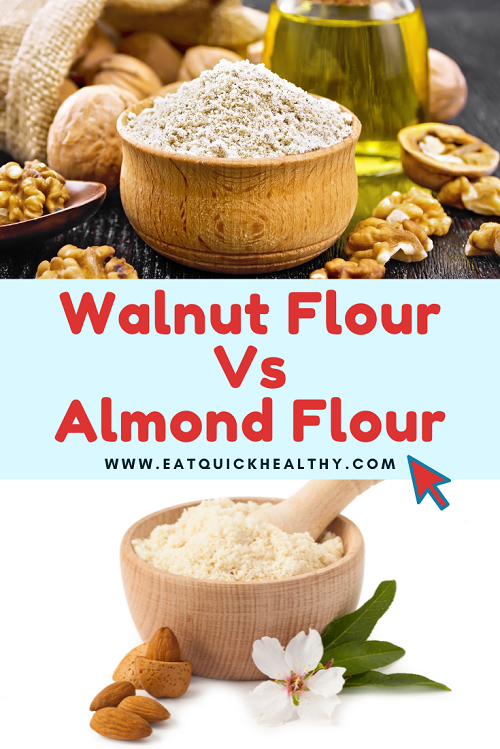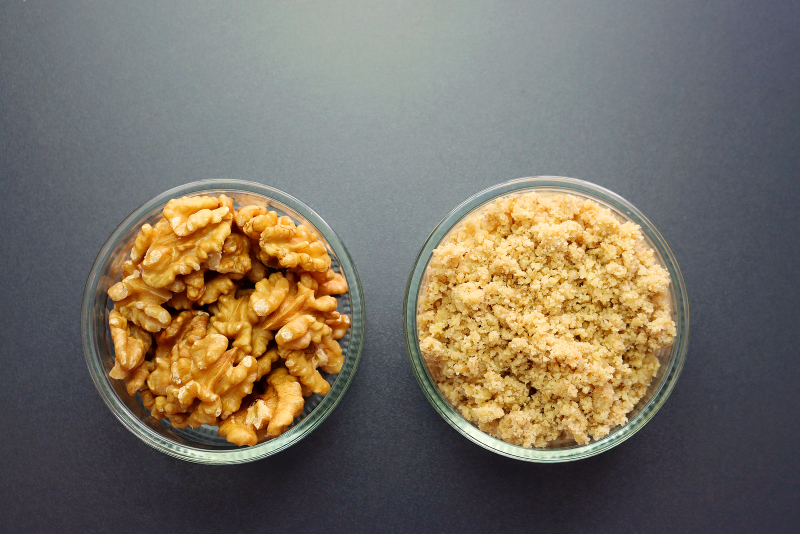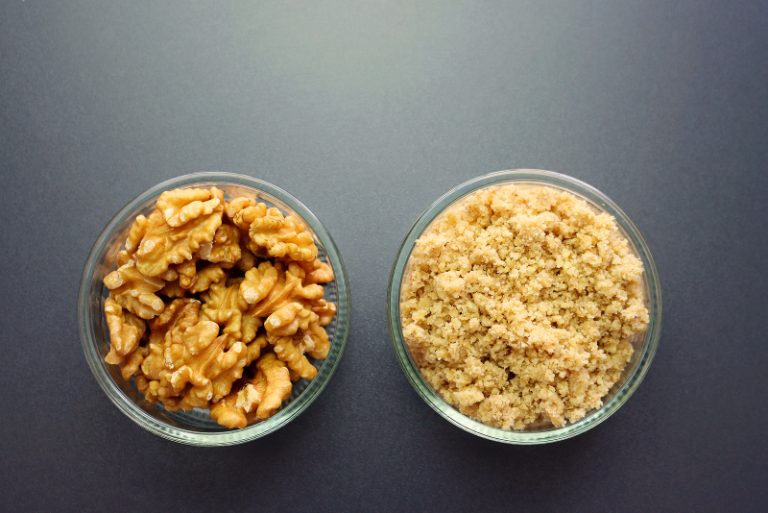Love using alternate flours which are great for a paleo diet, gluten free and easy to make at home? Both walnut and almond flours could be your answer.
Both flours are nutrient-rich, nutty and can be used in place of regular flour to varying degrees.
If you are wondering how they compare to each other, keep reading for our full explanation of what each of walnut flour and almond flour are before a complete walnut flour vs almond flour comparison. I also discuss whether you can substitute walnut flour for almond flour in cooking and vice versa.
Let’s start!

What Is Walnut Flour?

Walnut flour is simply made by grounding walnuts. You can do it yourself in a high-powered blender, although it’s recommended you just pulse it rather than blending it. This is because it can coagulate into a walnut butter.
Commerical walnut flours are generally made by extracting the oil from the walnut first to avoid this and then grounding the leftover cake.
Walnut flour is full of the same nutrients as walnuts such as fiber, copper, iron, magnesium and is about 37% protein. It’s gluten free and low in fat.
It can be used in baking or as a great alternative to breadcrumbs for crumbing your meat or making stuffing. Some people even like to put a teaspoon on their morning cereal for some extra nutrients.
The biggest thing to note with using walnut flour is that it does have its own distinct taste which can be bitter, and you will notice this in products you make with it. It also won’t help baked goods rise creating denser products.
Between these two facts, walnut flour is often used in conjunction with an additional flour – so you get the benefits of the walnut flour without getting such a strong taste and dense end products. Or in recipes where you just need a little flour.
What Is Almond Flour

Almond flour is made from blanched and skinned almonds which are then ground to make a fine grain flour. This can be done by soaking almonds in boiling water, drying them and then processing them until the flour grains are the size you want.
Almond flour is a very pale brown/off-white color and is gluten free. It has a mild taste which gives a toasted almond flavor in baking. Coming from nuts, it can be a useful ingredient when following a paleo diet.
Almond flour has lots of nutrients and is also high in protein and fat which makes it useful for people who want more protein in their food. The higher fat content helps to give a moist texture in baking things like muffins and brownies.
It can be a great alternative to regular flour in cakes, cookies and bread, but will lead to a denser end product.
If you are wondering how almond meal and almond flour differ, they are very similar. The difference is that almond meal is made by grounding the whole almonds, so without removing the skin. This gives a coarser texture, a darker color and can taste a little bitter.
So using almond meal does give slightly different results than using almond flour.
Walnut Flour Vs Almond Flour
Both walnut and almond flours are made from nuts so there are some similarities. They are both gluten free and low carb so work well for anyone looking for a flour like this. They also both contain healthy fats.
However, they also have some big differences.
What Are The Differences?
Since walnut and almond flours are made from different nuts, they do have some big differences.
Color
Since the skins of the walnut are not removed before they are ground into flour (like what happens when making almond flour), walnut flour is a noticeably darker color than almond flour. This can change the color of the end product that you are using the flour to make.
Taste
The biggest difference between the two has to be the taste, and this is primarily because the skins are left on the walnuts too. Almond flour has a mild nutty taste whereas walnut flour has a strong nutty flavor which can sometimes be bitter as well.
This taste difference does come across in cooking so it’s important you take this into account when choosing to use walnut flour.
Texture
Texture is also quite different between the two which also can make a big difference in cooking. Walnut flour is coarser than almond flour which is usually very fine. Walnut flour is closer to almond meal because of the skins being left on the walnuts.
Fat
There is about 25% more fat in walnut flour than almond flour. Note that these are healthy fats though.
Nutrients
Both almond flour and walnut flour have many nutrients, but overall, walnut flour wins. It has more calcium and iron as well as protein.
Which Is Best?
So is almond flour or walnut flour the winner?
It really depends what you want from your flour and what you are making. Almond flour is generally the easier flour to work with thanks to not having a strong taste and having a finer texture. There are more nutritional benefits from walnut flour, however.
Walnut flour is best used when you want a coarser texture and its stronger taste. It can work well as replacement for breadcrumbs or in pie crusts, for example.
For all these reasons, almond flour is usually the best replacement for regular flour.
Can I Substitute Walnut Flour For Almond Flour?
When it comes to substituting walnut flour for almond flour, you can do this. However, I would recommend not replacing all of it unless you are a big fan of the strong flavor of walnuts. The best way to use walnut flour is to just replace a fraction of the almond flour you are using.
The flours do work well together and bring moisture into the recipe although they aren’t as good as regular flour for binding ingredients together.
In the opposite direction, it is fine to substitute walnut flour with almond flour. The flours are both blended nuts so this can work well as long as you didn’t want the strong walnut flavor in your recipe or the coarser texture. Almond meal may be a better substitute in those cases.
Conclusion
I hope you have found this full guide to almond flour vs walnut flour useful and now know which flour you want to use when you are cooking.
The exact answer to which is best really depends on what you want to achieve in your cooking and what you have on hand. Enjoy!
You can also read my guide to almond flour vs all-purpose flour here, almond flour vs cashew flour here, almond flour vs rice flour here or click here to read more guides to almond products. Click here to find out how to store almond flour.


Comments are closed.